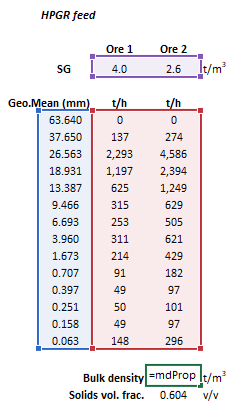Properties (Bulk Density)
Jump to navigation
Jump to search
Description
This article describes the Evertsson (1999) method for estimating the bulk density of a polydisperse particle ensemble.[1]
Model theory
Excel
The Evertsson bulk density estimation may be invoked from the Excel formula bar with the following function call:
=mdProps_BulkDensity_Evertsson(MeanSize as Range, Stream as Range, SG as Range, Optional returnPackFrac as Boolean = false)
Invoking the function with no arguments will print Help text associated with the model, including a link to this page.
The input parameters and calculation results are defined below in matrix notation, along with an example image showing the selection of the same cells and arrays in the Excel interface:
|
| ||||
References
- ↑ Evertsson, C.M., 1999. Size reduction in cone crushers. In Minerals Engineering Conference '99, Falmouth, England, 22-24 September 1999.
![{\displaystyle {\begin{aligned}MeanSize&={\begin{bmatrix}{\bar {d}}_{1}{\text{ (mm)}}\\\vdots \\{\bar {d}}_{31}{\text{ (mm)}}\\\end{bmatrix}}\\\\{\mathit {Stream}}&={\begin{bmatrix}(Q_{\rm {M}})_{11}{\text{ (t/h)}}&\dots &(Q_{\rm {M}})_{1m}{\text{ (t/h)}}\\\vdots &\ddots &\vdots \\(Q_{\rm {M}})_{n1}{\text{ (t/h)}}&\dots &(Q_{\rm {M}})_{nm}{\text{ (t/h)}}\\\end{bmatrix}}\\\\{\mathit {SG}}&={\begin{bmatrix}(\rho _{\rm {S}})_{1}{\text{ (t/m}}^{\text{3}}{\text{)}}&\dots &(\rho _{\rm {S}})_{m}{\text{ (t/m}}^{\text{3}}{\text{)}}\\\end{bmatrix}}\\\\{\mathit {returnPackFrac}}&={\big [}({\text{True / False)}}{\big ]}\end{aligned}}}](https://wikimedia.org/api/rest_v1/media/math/render/svg/d6d00b61b361e569269897963673990616be01b8)











